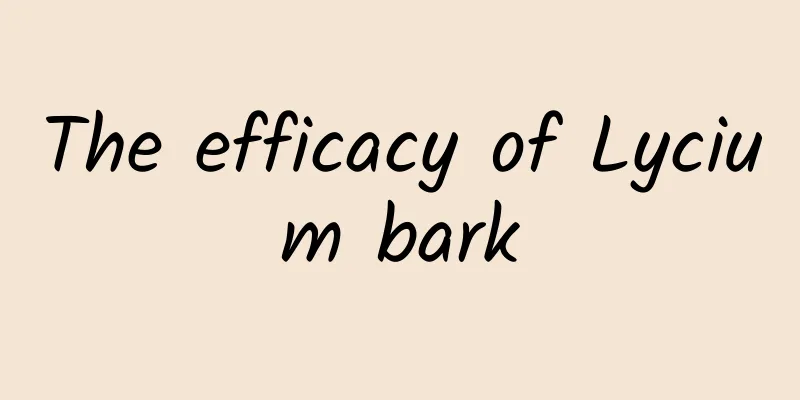The efficacy of Lycium bark

|
I believe that some people are not familiar with the traditional Chinese medicine Di Gu Pi. Di Gu Pi is actually the root bark of wolfberry, which is the outer coat of the wolfberry rhizome. Rehmannia root bark has the effect of clearing heat and detoxifying. It is also a rare and excellent product for relieving heat. People also often use it to treat diseases such as night sweats, lung heat, cough, blood, and ulcers. So what are the main effects and functions of Rehmannia glutinosa? Next let’s take a closer look. As for the effect on the cardiovascular system, intravenous injection of the extract, tincture and decoction of Radix Rehmanniae to anesthetized dogs, cats and rabbits had a significant antihypertensive effect, accompanied by a slower heart rate and faster breathing; oral administration to unanesthetized rats also had a significant antihypertensive effect. Intravenous injection of 0.375 g/kg of Lycium bark injection in anesthetized dogs can cause their blood pressure to drop to zero, resulting in death. Repeated injections of small doses did not show rapid tolerance. The methanol extract of Lycium bark also has significant antihypertensive activity when injected intravenously into rats at 0.5g (raw drug)/kg. During the antihypertensive period of Lycium bark, the electrocardiogram showed a slow heart rate, prolonged PR interval, and reduced T wave. A toxic dose can cause partial or even complete block of atrioventricular conduction in the guinea pig's heart. In addition to the central nervous system involvement, the antihypertensive effect of Lycium bark may also be related to its effect of blocking sympathetic nerve endings and directly relaxing blood vessels. In addition, Lycium barbarum A and Lycium barbarum B have anti-adrenocorticoid and renin effects, which is also one of their antihypertensive mechanisms. Hypoglycemic and hypolipidemic effects: When rabbits were gavaged with a decoction of Rehmannia glutinosa, their blood sugar levels first increased for a short period of time, then decreased for a long time, and had not recovered after 4 to 8 hours. It has no obvious antagonistic effect on hyperglycemia caused by injection of adrenaline, but it can shorten the duration of hyperglycemia. Subcutaneous injection of Rehmannia glutinosa extract in rabbits can also lower blood sugar. The water decoction of Radix Lycii has a certain effect in alleviating the morphological and structural damage of pancreatic islet B cells in alloxan diabetic mice. Intragastric administration of Rehmannia glutinosa extract can reduce the serum total cholesterol content of experimental rabbits, but has little effect on triglyceride content and no obvious effect on liver fat content. Betaine has anti-fatty liver effects. Anti-pathogenic microbial effect: The decoction of Radix Rehmanniae has a strong inhibitory effect on Salmonella typhi, Salmonella paratyphi A and Shigella flexneri, but has no effect on Staphylococcus aureus; it has an inhibitory effect on the cytopathic effect of the Asian influenza A Jingke 68-1 virus strain; it is a low-efficiency antibacterial drug for Mycobacterium tuberculosis. Antipyretic effect: Oral administration or injection of the water extract, ethanol extract and ether residue water extract of the Cortex Lycii had a significant antipyretic effect on artificially fevered rabbits. Its ether extract and the aqueous extract of the residue after ethanol extraction had no effect. Its antipyretic effect is weaker than that of aminopyrine and is approximately equal to that of other antipyretics. Other effects: The decoction of Radix Rehmanniae has an inhibitory effect on the production of interleukin-2 by spleen cells of normal mice; it has a significant enhancing effect on the reduced interleukin-2 production by spleen cells of mice induced by cyclophosphamide; and it has an inhibitory effect on the abnormal interleukin-2 production induced by azathioprine. Through the above detailed introduction to the effects of Rehmannia glutinosa. For people who usually suffer from hepatitis, ulcers, hot flashes, night sweats, urinary obstruction, and red and white turbid urine, it may be advisable to take an appropriate amount of decocted Rehmannia root bark orally. It can also help to relieve kidney fire, reduce latent fire in the lungs, and replenish vital energy. However, it should be noted that people with weak spleen and stomach should not eat Rehmannia root bark. |
<<: What are the effects of rush?
>>: What are the effects and functions of Ginkgo biloba fruit
Recommend
If you collect all the farts from cows in a day, you can actually boil 20 liters of water?
Global warming has exacerbated glacier melting an...
The efficacy and function of perilla leaves
White perilla leaf is a relatively familiar tradi...
What are the uses of licorice?
When it comes to Chinese medicinal materials, the...
The efficacy and function of the safflower
Many people are not very clear about the effects ...
The efficacy and function of red cohosh
Red cohosh is a very common medicinal material in...
What are the main effects of drinking Lingzhi tablets soaked in water?
Medical research and discovery have shown that Ga...
An unexpected discovery: Cancer cells are more active when we sleep?
Some scientists stay up until the early hours of ...
The efficacy and function of Yisaoguang
I don't know if you have heard of the term &q...
What are the ways to eat Poria cocos?
Poria cocos is a relatively common Chinese medici...
As the universe continues to expand, will there be a critical point? What will be the final destination?
This article is based on answering netizens' ...
The efficacy and function of peach branches
Peach branch is a very familiar medicinal materia...
It is a "cheap eye-protecting vegetable". The more you eat it, the brighter your eyes will be! It can also supplement calcium and resist aging. It is now on the market!
Recently, amaranth is in season. As the old sayin...









